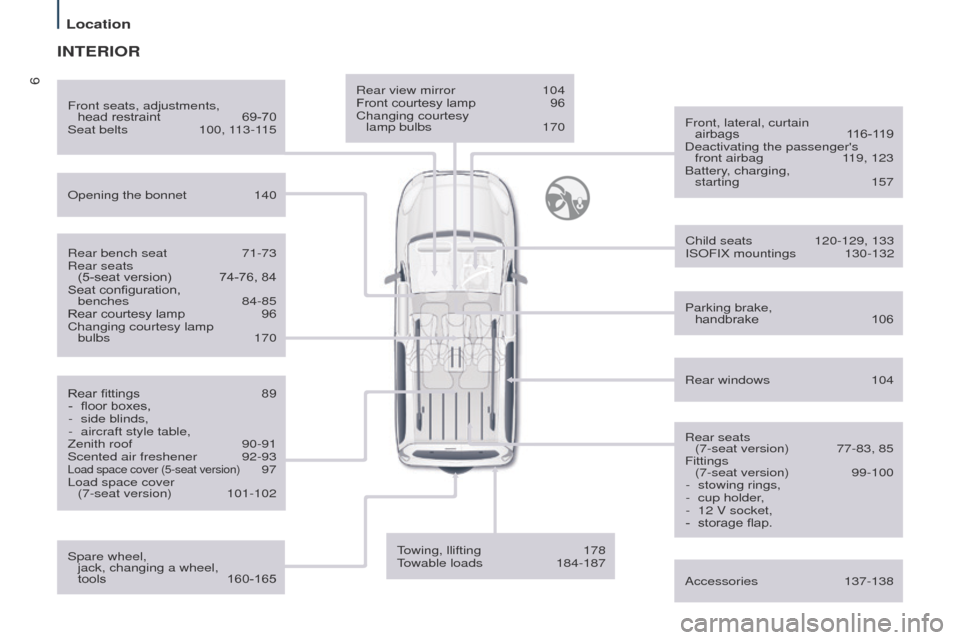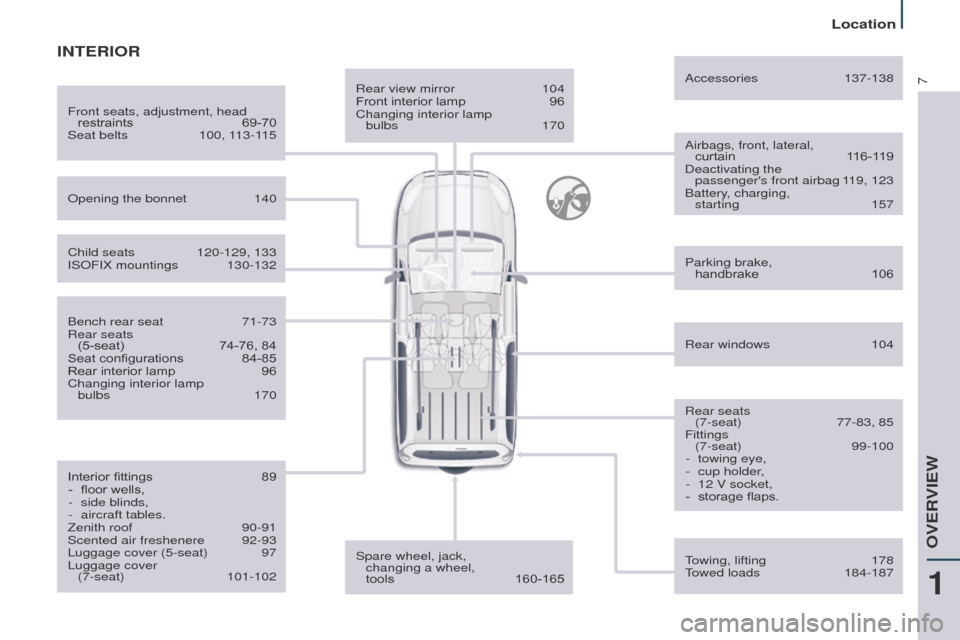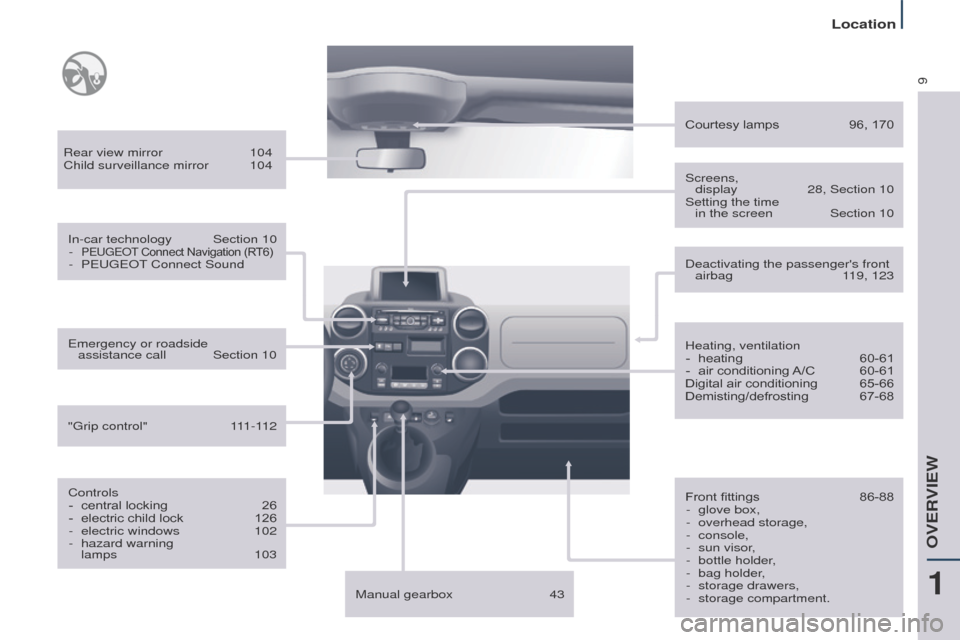window Peugeot Partner Tepee 2015 Owner's Manual
[x] Cancel search | Manufacturer: PEUGEOT, Model Year: 2015, Model line: Partner Tepee, Model: Peugeot Partner Tepee 2015Pages: 276, PDF Size: 12.76 MB
Page 4 of 276

2
Partner_2_VP_en_Chap00a_Sommaire_ed02-2014
Key 18
Alarm 20
Doors
21tailgate
23
Rear roof flap
26
Central locking
27
Instrument panel
28
Adjusting the time
29
W
arning lamps
30
Fuel gauge
38
Coolant
38
Under-inflation detection
39
Service indicator
41
Lighting dimmer
42
Steering
wheel adjustment
43
Manual gearbox
43g
ear shift indicator
44
6-speed electronic
gearbox
45
Stop & Start
47
Starting and stopping
50
Hill start assist
51Lighting control
52
wipers 55
Cruise control
57
Speed limiter
60
Heating /
Air conditioning
manual
63 digital
65
Demisting and defrosting
6
7
Front seats
69
Rear bench seat
71
Rear seats
(5 seat version)
74
Rear seats
(7 seat version)
77
Modularity
84
Front fittings
86
Zenith roof
90
Roof bars
95
Courtesy lamps
96
Load space cover
(5 seat version)
97
Load space cover
(7 seat version)
101
Mirrors
103e
lectric windows
105
READY
TO SET OFF
3.
18-51 SAFETY
5.
106-134
Locatione
xterior 5
Interior
6
Instruments and controls
8technical data - Maintenance
12
Instruments and controls Left hand drive
13
Right hand drive
14
OVERVIEW
1.
4-14
Hazard warning lamps 106
Parking brake 106
Parking sensors
107
Anti-lock braking system (ABS)
109
e
mergency braking assistance
109
ASR and DSC
1
10
g
rip control
1
11
Seat belts
1
13
Airbags
1
16
Child seats
120
Deactivating the passenger's
front airbag
1
23
Recommended seats
126
Installation
128
ISOFIX seats
132
Child lock
134
EASE OF USE and
COMFORT
4.
52-105
2.
15-17
ECO-DRIVING
environment 15
Eco-driving 16
t
he "Visual Search " (visual
index) section assists
you in finding the controls
and functions and their
associated page numbers
on the schematic outlines of
the vehicle.
Contents
Page 8 of 276

6
Partner_2_VP_en_Chap01_vue-ensemble_ed02-2014
Rear view mirror 104
Front courtesy lamp 96
Changing courtesy
lamp bulbs
170 Front, lateral, curtain
airbags
1
16-119
Deactivating the passenger's front airbag
1
19, 123
Battery, charging, starting
157
Opening the bonnet
140
Rear windows
104
Front seats, adjustments,
head restraint
69-70
Seat belts
100, 1
13-115
Accessories
137-138
INTERIOR
Rear bench seat 71-73
Rear seats
(5-seat version)
74-76, 84
Seat configuration,
benches
84-85
Rear courtesy lamp
96
Changing courtesy lamp
bulbs
170
Rear fittings
89
-
floor boxes,
-
side blinds,
-
aircraft style table,
Zenith roof
90-91
Scented air freshener
92-93Load space cover (5-seat version) 97
Load space cover
(7-seat version)
101-102 Child seats
120-129, 133
ISOFIX mountings
130-132
Parking brake,
handbrake
106
Rear seats
(7-seat version)
77-83, 85
Fittings
(7-seat version) 99-100
-
stowing rings,
-
cup holder
,
-
12 V socket,
-
storage flap.
towing, llifting
178towable loads
184-187
Spare wheel,
jack, changing a wheel,
tools
160-165
Location
Page 9 of 276

7
Partner_2_VP_en_Chap01_vue-ensemble_ed02-2014
Rear view mirror 104
Front interior lamp 96
Changing interior lamp
bulbs
170 Airbags, front, lateral,
curtain
1
16-119
Deactivating the passenger's front airbag
1
19, 123
Battery, charging, starting
157
Opening the bonnet
140
Rear windows
104
Front seats, adjustment, head
restraints
69-70
Seat belts
100, 1
13-115 Accessories
137-138
INTERIOR
Bench rear seat 71-73
Rear seats
(5-seat)
74-76, 84
Seat configurations
84-85
Rear interior lamp
96
Changing interior lamp
bulbs
170
Interior fittings
89
-
floor wells,
-
side blinds,
-
aircraft tables.
Zenith roof
90-91
Scented air freshenere
92-93
Luggage cover (5-seat)
97
Luggage cover
(7-seat)
101-102
Child seats
120-129, 133
ISOFIX mountings
130-132
Parking brake,
handbrake
106
Rear seats
(7-seat)
77-83, 85
Fittings
(7-seat)
99-100
-
towing eye,
-
cup holder
,
-
12 V socket,
-
storage flaps.
towing, lifting
178towed loads
184-187
Spare wheel, jack,
changing a wheel,
tools
160-165
1
OVeRVIeW
Location
Page 11 of 276

9
Partner_2_VP_en_Chap01_vue-ensemble_ed02-2014
Rear view mirror 104
Child surveillance mirror 104
In-car technology
Section 10
-
PeugeOt Connect Navigation (R T6)- PeugeO t Connect Sound
Controls -
central locking
26
-
electric child lock
126
-
electric windows
102
-
hazard warning
lamps
103
e
mergency or roadside assistance call
Section 10
"
g rip control"
1
11-112 Heating, ventilation
-
heating
60-61
-
air conditioning
A/C
60-61
Digital air conditioning
65-66
Demisting/defrosting
67-68
Courtesy lamps
96, 170
Front fittings
86-88
-
glove box,
-
overhead storage,
-
console,
-
sun visor
,
-
bottle holder
,
-
bag holder
,
-
storage drawers,
-
storage compartment.
Screens,
display
28, Section 10
Setting the time
in the screen
Section 10
Deactivating the passenger's front airbag
1 19, 123
Manual gearbox
43
1
OVeRVIeW
Location
Page 13 of 276

11
Partner_2_VP_en_Chap01_vue-ensemble_ed02-2014
Fuses, dashboard, cabin 173-175
Bonnet release lever
140
Front fititngs
86-88
-
glove box,
-
roof storage,
-
console,
-
sun visor
,
-
bottle holder
,
-
bag holder
,
-
storage drawers,
-
storage compartment.
Rear view mirror
104
Child surveillance mirror
104
e
mergency or assistance
call
Section 10
Manual gearbox
43
technology on-board
Section 10
-
PeugeOt
Connect Navigation (R T6)- PeugeO t Connect Sound (RD5)
Controls -
central locking
26
-
electric child lock
126
-
electric windows
102
-
hazard warning lamps
103
"
g rip control"
1
11-112
Heating, ventilation -
heating
60-61
-
air conditioning
A/C
60-61
Digital air conditioning
65-66
Demisting-defrosting
67-68
Courtesy lamps
96, 170
Screens,
display
28, Section 10
Setting the time in
the screen
Section 10
1
OVeRVIeW
Location
Page 15 of 276

13
Partner_2_VP_en_Chap01_vue-ensemble_ed02-2014
INSTRUMENTS AND CONTROLS
1. Lighting and direction indicator
stalk.
2.
Instrument panel with screen.
3.
Wipers, screenwash, trip
computer control stalk.
4.
Ignition.
5.
Audio system controls.
6.
Driver's front airbag, horn.
7.
Steering wheel height and reach
adjustment.
8.
Cruise control, speed limiter
controls.
9.
Switch panel, parking sensors,
headlamp beam adjustment,
e
SC, Stop & Start.
10.
Bonnet
release.
11 .
e lectric door mirror adjustment.
12.
e lectric window switches.
13.
Switch panel: hazard warning
lamps, central locking, child lock.
14.
Cigarette
lighter.
15.
Heating-ventilation
controls.
16.
Storage
compartment.
17.
e lectronic gearbox controls or
g
rip control.
18.
Audio
equipment.
19.
Screen.
20.
e mergency or assistance call.
1
OVeRVIeW
Presentation
Page 16 of 276

14
Partner_2_VP_en_Chap01_vue-ensemble_ed02-2014
INSTRUMENTS AND CONTROLS
1. Lighting and direction indicator
control stalk.
2.
Instrument panel with screen.
3.
Wiper
, screenwash, trip
computer control stalk.
4.
Ignition switch.
5.
Audio system controls.
6.
Driver's front airbag, horn.
7.
Steering wheel height and reach
adjustment.
8.
Cruise control, speed limiter
controls.
9.
Switch panel, parking sensors,
headlamp beam adjustment,
e
SC, Stop & Start, alarm.
10.
Bonnet release lever
.
11 .
e lectric door mirror controls.
12.
e lectric window switches.
13.
Switch panel: hazard warning,
central locking, child lock.
14.
Cigarette
lighter.
15.
Heating-ventilation
controls.
16.
Door
pockets.
17.
e lectronic gearbox controls or
g
rip control.
18.
Audio
system.
19.
Screen.
20.
e mergency or assistance call.
Presentation
Page 18 of 276

16eco-driving is a range of everyday practices that allow the motorist to o\
ptimise their fuel consumption and CO2
emissions.
Eco-driving
Optimise the use of your gearbox
With a manual gearbox, move off gently and change up
without waiting. During acceleration change up early.
With an automatic or electronic gearbox, give preference
to automatic mode and avoid pressing the accelerator
pedal heavily or suddenly.
t
he gear shift indicator invites you engage the most
suitable gear: as soon as the indication is displayed in the
instrument panel, follow it straight away.
For vehicles fitted with an electronic or automatic gearbox,
this indicator appears only in manual mode.
Drive smoothly
Maintain a safe distance between vehicles, use engine
braking rather than the brake pedal, and press the
accelerator progressively.
t
hese practices contribute
towards a reduction in fuel consumption and CO
2
emissions and also helps reduce the background traffic
noise.
If your vehicle has cruise control, make use of the system
at speeds above 25 mph (40 km/h) when the traffic is
flowing well.
Control the use of your electrical equipment
Before moving off, if the passenger compartment is too
warm, ventilate it by opening the windows and air vents
before using the air conditioning.
Above 30 mph (50 km/h), close the windows and leave the
air vents open.
Remember to make use of equipment that can help keep
the temperature in the passenger compartment down
(sunroof and window blinds...).
Switch off the air conditioning, unless it has automatic
regulation, as soon as the desired temperature is attained.
Switch off the demisting and defrosting controls, if not
automatic.
Switch off the heated seat as soon as possible.
Switch off the headlamps and front foglamps when the
level of light does not require their use.
Avoid running the engine before moving off, particularly in
winter; your vehicle will warm up much faster while driving.
As a passenger, if you avoid connecting your multimedia
devices (film, music, video game...), you will contribute
towards limiting the consumption of electrical energy, and
so of fuel.
Disconnect your portable devices before leaving the
vehicle.
Motoring & environment
Page 22 of 276

20
Partner_2_VP_en_Chap03_Pret-a-partir_ed02-2014
When leaving the vehicle, check that
the lamps are off and nothing of value
is visible.
As a safety precaution (with children
on board), remove the key from the
ignition when leaving the vehicle, even
for a short time.
Good practice
Do not make any modifications to the
electronic immobiliser system.
Operating the remote control, even
when it is in your pocket, may result in
involuntary unlocking of the doors.
t
he simultaneous use of other
high frequency equipment (mobile
telephones, domestic alarms…), may
interfere with the operation of the
remote control temporarily.
t
he remote control does not operate
while the key is in the ignition, even if
the ignition is off.
ELECTRONIC IMMOBILISER
All of the keys contain an electronic
immobiliser device.
t
his device locks the engine supply
system. It is activated automatically
when the key is removed from the
ignition.
After the ignition is switched on, a
dialogue is established between the
key and the electronic immobiliser
system.
t
he metal part of the key must be
unfolded correctly for correct dialogue
to take place.
If you lose your keys
Visit a P
euge O t
dealer with the
vehicle's V5 registration document and
your identification document.
A
P euge O t
dealer will be able
to retrieve the key code and
the transponder code so that a
replacement key can be ordered. When purchasing a second-hand
vehicle:
-
have the keys memorised by a
P
euge O t
dealer to ensure that
the keys in your possession are
the only ones which can start the
vehicle.
ALARM
If fitted on your vehicle, this provides
two types of protection:
-
exterior protection: it sounds if a
front/rear door or the bonnet is
opened.
-
interior protection: it sounds if
the volume inside the passenger
compartment changes (breaking of
a window or a movement inside the
vehicle).
If
your vehicle is fitted with a separation
partition, the interior protection is not
active in the load space.
Locking the vehicle with
complete alarm
Setting the alarm
- Switch of f the ignition and get out of
the vehicle.
-
Set the alarm within five minutes of
getting out of the vehicle, by locking
or deadlocking using the remote
control.
t
he red L e D, located in the
button, flashes once per second.
Access
Page 23 of 276

21
Partner_2_VP_en_Chap03_Pret-a-partir_ed02-2014
FRONT DOORS
From the inside
use the door opening control to unlock
and open the door concerned.
From the outside
use the remote control to lock/unlock
the vehicle.
Insert the metal part of the key in the
lock on the driver's side if the remote
control does not work.
Disarming
- unlock the vehicle with the remote
control or switch on the ignition, the
red L
e D goes off.
Locking the vehicle with
exterior protection only
If, while you are away from the
vehicle, you wish to leave a window
partially open or a pet inside the
vehicle, you should choose exterior
protection only.
-
Switch of
f the ignition.
-
In the next ten seconds,
press the button until
the red L
e D is on
continuously.
-
g et out of the vehicle.
-
Within the next five minutes, set
the alarm by locking or deadlocking
using the remote control (the red
LED flashes once a second).
Triggering
the siren sounds, the direction indicators
flash for approximately 30 seconds and
the red LED flashes rapidly.
-
t
o switch it of
f, insert the key and
switch on the ignition.
When the alarm has been triggered ten
times in succession (when triggered for
the eleventh time) it is deactivated. Repeat
the procedure for setting the alarm.
Locking the vehicle without
alarm
- Insert the key in the lock on the
driver's door and lock it.
Do not set the alarm when washing
your vehicle.
Failure of the remote control
When the alarm is set but the remote
control does not operate:
-
u nlock the doors with the key and
open the door.
t
he alarm is triggered.
-
Switch on the ignition in the next
ten
seconds.
t
he alarm is disarmed.
Incorrect operation
When the ignition is switched on, if the
red Le D remains on for ten seconds,
there is a fault in the siren connection.
Contact a P
euge O t
dealer to have
the system checked.
Automatic setting of the alarm
Depending on the country in which
the vehicle is sold, the alarm is set
automatically approximately 2 minutes
after the last door is closed.
to prevent triggering of the alarm when
a door is opened, you have to press
the remote control unlocking button
again.
Do not make any modifications
to the alarm system as this could
cause faults.
Access
ReADY tO Set OFF
3